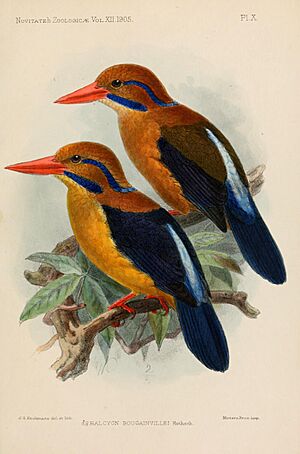Moustached kingfisher facts for kids
Quick facts for kids Moustached kingfisher |
|
|---|---|
 |
|
| Conservation status | |
| Scientific classification | |
| Genus: |
Actenoides
|
| Species: |
bougainvillei
|
| Subspecies | |
|
|
The moustached kingfisher (Actenoides bougainvillei) is a special kind of bird. It belongs to the Alcedinidae family, which includes all kingfishers. This bird is found only on Bougainville Island in Papua New Guinea.
Sadly, there are not many moustached kingfishers left. Scientists believe only about 250 to 1,000 adult birds remain. They live in warm, wet forests, both in lowlands and on mountains. These birds build their nests in holes in trees. Their homes are shrinking, and new animals brought to the island are also a threat.
The Guadalcanal moustached kingfisher used to be thought of as the same bird. But now, experts know it is a different species. The moustached kingfisher was first described in 1904. Later, in the 1930s, about a dozen birds were studied from Bougainville. In 2015, a team from the American Museum of Natural History found and studied another male bird.
Contents
What Does the Moustached Kingfisher Look Like?
This amazing bird is about 32 centimeters (12.5 inches) long. It has a large bill that is orange to red. Its "moustache," wings, and tail are a beautiful purple-blue color.
There are two main types, or subspecies, of the moustached kingfisher:
A. b. bougainvillei: The Bougainville Kingfisher
This subspecies lives on Bougainville Island. The adult male has a dark orange-brown head, cheeks, and back. A thin, purple-blue line goes from behind its eye to its neck. A wider purple-blue stripe forms a long "moustache" under its cheeks.
Its upper back, wings, and tail are a dark purple-blue. The lower back and rump are a bright, light blue. The bird's belly is orange-red, becoming lighter on the chin and lower belly. Its bill is red, and its eyes are dark brown. The legs and feet have brown nails.
The adult female looks much like the male. However, her upper back, wings, and certain flight feathers are olive green. Her head is also a darker orange-brown.
A. b. excelsus: The Guadalcanal Kingfisher
This subspecies is found on Guadalcanal in the Solomon Islands. The adult female of this type has more olive-green on her back and wings. Her belly is also much lighter orange than the Bougainville type. A young male of this subspecies has a very dark olive-green upper back and wings.
The International Union for Conservation of Nature currently lists the moustached kingfisher as "Least Concern." This means they are not in immediate danger of disappearing.
Where Do Moustached Kingfishers Live?
These birds live in lowland forests and hill forests in southern Bougainville. They also live in hill and mist forests on Guadalcanal, usually between 550 and 1250 meters high.
In the 1950s, local people saw holes in riverbanks or in the forest ground. They thought these might be nests of the moustached kingfisher. It is believed that these birds will nest in any suitable hole they find.
How Do Moustached Kingfishers Behave?
The moustached kingfisher is a "perch hunter." This means it sits on a branch and waits. It then quickly flies down to catch insects and small animals. Its rounded wings and short tail help it fly fast and straight.
Its eyes are very special. They help the bird see its prey accurately from far away. The bird can also turn its head very wide to look around. Moustached kingfishers are thought to be territorial. This means breeding pairs will protect their own area.
These birds have been seen diving into water many times. They do this to clean off any dirt that might stick to them from their nests.
The moustached kingfisher usually calls out before the sun rises and after it sets. Its call is a loud, laughing sound, like "ko-ko-ko-ko."


